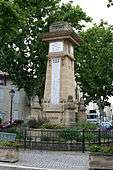Saint-Cannat
| Saint-Cannat | ||
|---|---|---|
|
Town hall | ||
| ||
 Saint-Cannat | ||
|
Location within Provence-A.-C.d'A. region  Saint-Cannat | ||
| Coordinates: 43°37′12″N 5°17′55″E / 43.62°N 5.2986°ECoordinates: 43°37′12″N 5°17′55″E / 43.62°N 5.2986°E | ||
| Country | France | |
| Region | Provence-Alpes-Côte d'Azur | |
| Department | Bouches-du-Rhône | |
| Arrondissement | Aix-en-Provence | |
| Canton | Lambesc | |
| Intercommunality | Pays d'Aix | |
| Government | ||
| • Mayor (2008–2014) | Jacky Gérard | |
| Area1 | 36.54 km2 (14.11 sq mi) | |
| Population (2008)2 | 5,347 | |
| • Density | 150/km2 (380/sq mi) | |
| Time zone | CET (UTC+1) | |
| • Summer (DST) | CEST (UTC+2) | |
| INSEE/Postal code | 13091 / 13760 | |
| Elevation |
159–391 m (522–1,283 ft) (avg. 212 m or 696 ft) | |
|
1 French Land Register data, which excludes lakes, ponds, glaciers > 1 km² (0.386 sq mi or 247 acres) and river estuaries. 2 Population without double counting: residents of multiple communes (e.g., students and military personnel) only counted once. | ||
Saint-Cannat is a commune in the Bouches-du-Rhône department in southern France.
History
The village was named after Canus Natus, a fifth century Roman Catholic Saint, who was a Roman clergyman born with white hair, a quirk synonymous with great wisdom at the time.[1] He was buried in Saint-Cannat, although there was no such place at the time, but soon enough several houses were built into a hamlet.[1]
In the twelfth century, Archbishop Pierre mentioned, 'Castrum Santi - Cannati' in a paper.[1]
In the thirteenth century, villagers turned on their archbishop and pledged allegiance to the Lord of the Baux-de-Provence, and then to the Kings of Sicily (namely, Frederic III of Aragon, or perhaps Louis XIII).[1] This, however, only lasted three years.[1] In the same century, the Knights Templar established a settlement there.[1]
Pierre André de Suffren was born here on 17 July 1729.[1] A century later, Alphonse Tavernier, a poet, was born here on 27 November 1852.
On June 11, 1909, a terrible earthquake destroyed almost everything.[1] Shortly after, the houses were re-built in the same architectural style.[1] Both in 1984 and 1994 huge floods ravaged most houses.[1]
It has retained several fountains dating back to the 17th and 18th century, the remains of the medieval ramparts and the chateau, which today houses the town hall and museum.[1] The Route nationale 7 bisects the village.
There is a polo club, Polo Club de Saint Cannat, opened in the 1970s.[2] It organizes the Open d'Aix and the Tournoi de Noel every year.[3]
There is also an entertainment park called Village des automates.[4]
It is also home to the winery Château de Beaupré, started by Baron Emile Double (1869-1938) in 1890.[5]
The creek Budéou flows through the village.
Population
| Historical population | ||
|---|---|---|
| Year | Pop. | ±% |
| 1793 | 1,759 | — |
| 1800 | 2,009 | +14.2% |
| 1806 | 1,921 | −4.4% |
| 1821 | 1,813 | −5.6% |
| 1831 | 1,655 | −8.7% |
| 1836 | 1,701 | +2.8% |
| 1841 | 1,721 | +1.2% |
| 1846 | 1,994 | +15.9% |
| 1851 | 2,006 | +0.6% |
| 1856 | 1,983 | −1.1% |
| 1861 | 1,929 | −2.7% |
| 1866 | 1,812 | −6.1% |
| 1872 | 1,710 | −5.6% |
| 1876 | 1,535 | −10.2% |
| 1881 | 1,403 | −8.6% |
| 1886 | 1,269 | −9.6% |
| 1891 | 1,235 | −2.7% |
| 1896 | 1,212 | −1.9% |
| 1901 | 1,292 | +6.6% |
| 1906 | 1,232 | −4.6% |
| 1911 | 1,278 | +3.7% |
| 1921 | 1,058 | −17.2% |
| 1926 | 1,135 | +7.3% |
| 1931 | 1,137 | +0.2% |
| 1936 | 1,074 | −5.5% |
| 1946 | 1,034 | −3.7% |
| 1954 | 1,086 | +5.0% |
| 1962 | 1,254 | +15.5% |
| 1968 | 1,675 | +33.6% |
| 1975 | 1,862 | +11.2% |
| 1982 | 2,384 | +28.0% |
| 1990 | 3,918 | +64.3% |
| 1999 | 4,626 | +18.1% |
| 2008 | 5,347 | +15.6% |
Gallery
| Saint-Cannat | ||||||||
|---|---|---|---|---|---|---|---|---|
|
References
External links
| Wikimedia Commons has media related to Saint-Cannat. |

.svg.png)



